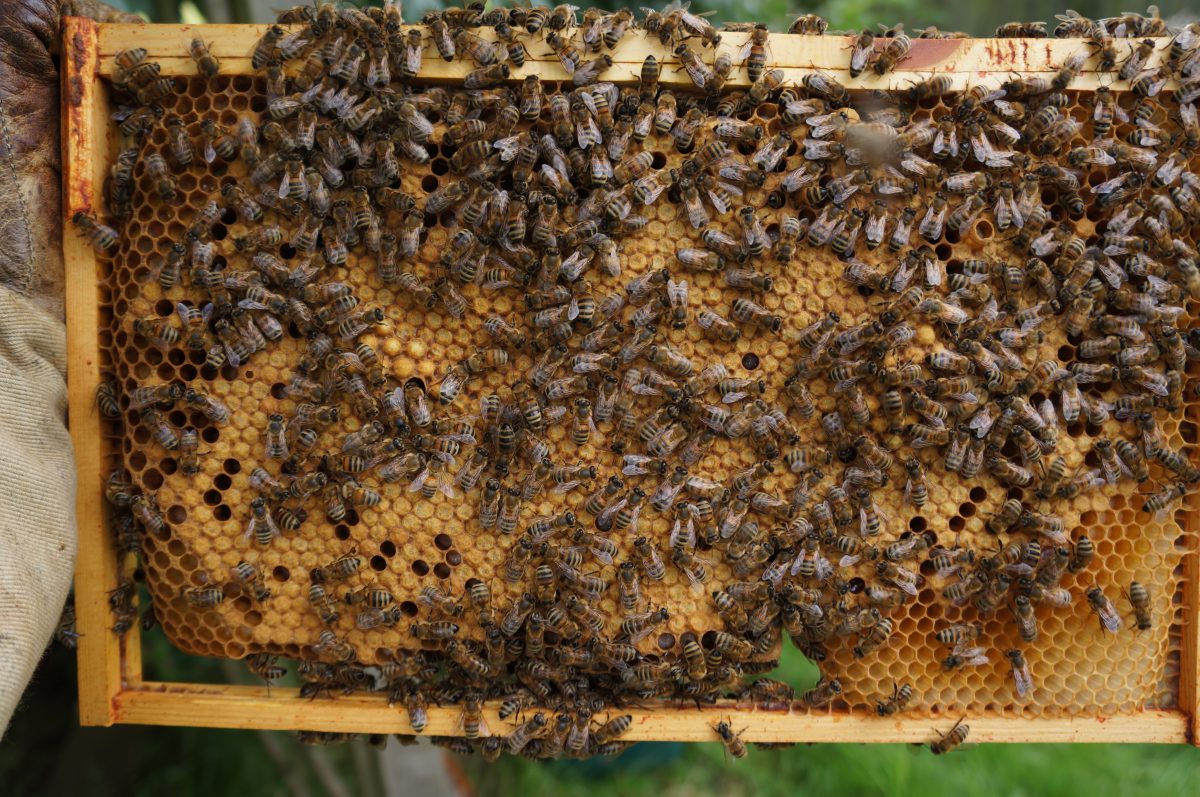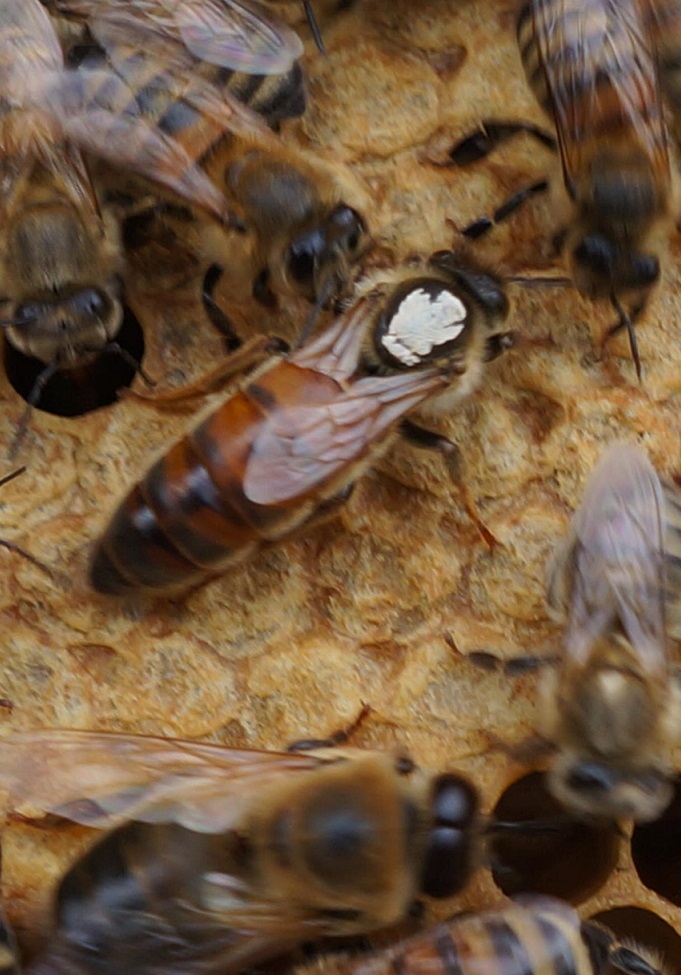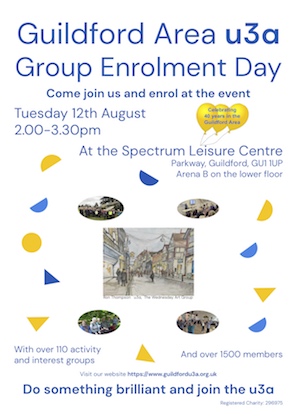 Abraham Lincoln
If given the truth, the people can be depended upon to meet any national crisis...
Abraham Lincoln
If given the truth, the people can be depended upon to meet any national crisis...
 Guildford news...
for Guildford people, brought to you by Guildford reporters - Guildford's own news service
Guildford news...
for Guildford people, brought to you by Guildford reporters - Guildford's own news service
Beekeeper’s Notes July 2016: Queen For Sale
Published on: 1 Jul, 2016
Updated on: 2 Jul, 2016
Hugh Coakley keeps bees in Worplesdon and writes a regular column on beekeeping. He talks this month about the wonderful world of queens.
It is always nice to have some quality in the family and that is never more true than when it comes to replacing royalty.
A good queen is so important in a hive. Yet, it is often no more than pot luck when an amateur beekeeper is replacing a queen in one of his hives.

A healthy frame of brood laid by my new Buckfast queen. She is laying like a champion! Click on the picture to enlarge it.
What the beekeeper wants is a queen who is a good layer, will produce healthy bees with good temperament and in whose nature it is to bring in a delightful surplus of nectar.
That is easier said than done.
The options the beekeeper has are to breed queens from his own stock or buy in new queens.
Using your own bees is certainly the cheapest way. And there are various methods which beekeepers use with varying degree of success.
The uncertainty comes with not only getting a good, healthy queen but then not knowing the sort of drones that the virgin queen will mate with.
As an amateur, the mating side is pure luck. The queen will head off on her mating flights and will come back – providing she hasn’t been eaten by a passing swallow – having mated with a number of drones.
This does ensure diversity but you can get some unwelcome traits creeping in.
I generally try to make queens from my own bees but I have to say, I am not very good at it and it is a bit hit or miss.
This year, I decided to buy in two Buckfast queens to improve my stock of bees.

My Buckfast Queen – photographed on Thursday, June 30. Note that the left wing has been clipped which means it is easier to prevent swarming. It doesn’t appear to cause the queen any harm and the workers, who will very quickly reject an imperfect queen, completely ignore the missing wing.
Originally bred by Brother Adam in Buckfast Abbey, the Buckfast bee is reputed to be very placid, prolific, with a low tendency to swarm and great honey producers.
At £42 per queen, I hope that they live up to their reputation.
But that is on the cheap end when it comes to quality queens. You can pay several hundred pounds for a queen that has been island mated – isolation on an island means that drones can be selected – or artificially inseminated queens where you can guarantee not only the queen’s parentage but also the drone’s.
Responses to Beekeeper’s Notes July 2016: Queen For Sale
Leave a Comment Cancel reply
Please see our comments policy. All comments are moderated and may take time to appear. Full names, or at least initial and surname, must be given.
Click on cartoon for Dragon story: Public Asked for Views on SCC’s Proposal for Reduced Speed Limits



Recent Articles
- Residents Hit By CIL Fees Should Be Offered Full Review, Says Overview Committee
- Plans For New Guildford Preschool Rejected On Road Safety Grounds
- Expert in AI Is New Head of the University of Surrey
- From East Clandon to Paris – Charity Cyclists Complete Epic 24-hour Challenge
- Updated: Local MPs Vote in Favour of Assisted Dying
- Guildford Plans Three-Day Celebration In a Festival of History And Culture
- Local Therapy Garden Supporting Mental Health Shortlisted for BBC Award
- Thousands of Year Six Pupils at Guildford Cathedral for a Special Send Off
- New Surrey Research to Find Solutions to Local Challenges
- Comment: What Are We To Make of the GBC Executive ‘Reshuffle’?


Recent Comments
- John Redpath on ‘Politics Is Not Always a Kind Place’ Says Dismissed Lead Councillor
- Jules Cranwell on ‘Politics Is Not Always a Kind Place’ Says Dismissed Lead Councillor
- Ben Paton on ‘Politics Is Not Always a Kind Place’ Says Dismissed Lead Councillor
- Angela Gunning on ‘Politics Is Not Always a Kind Place’ Says Dismissed Lead Councillor
- Nigel Keane on A281 At Shalford Has Now Reopened Following Repairs to Damaged Roof
- N Hatcher on New Electric Trains Now Arriving at Guildford – 100 Years After the First One Did
Search in Site
Media Gallery
Dragon Interview: Local Artist Leaves Her Mark At One of England’s Most Historic Buildings
January 21, 2023 / No Comment / Read MoreDragon Interview: Lib Dem Planning Chair: ‘Current Policy Doesn’t Work for Local People’
January 19, 2023 / No Comment / Read MoreA3 Tunnel in Guildford ‘Necessary’ for New Homes, Says Guildford’s MP
January 10, 2023 / No Comment / Read More‘Madness’ for London Road Scheme to Go Ahead Against ‘Huge Opposition’, Says SCC Leader
January 6, 2023 / No Comment / Read MoreCouncillor’s Son Starts Campaign for More Consultation on North Street Plan
December 30, 2022 / No Comment / Read MoreCounty Council Climbs Down Over London Road Works – Further ‘Engagement’ Period Announced
December 14, 2022 / No Comment / Read MoreDragon Interview: GBC Reaction to the Government’s Expected Decision to Relax Housing Targets
December 7, 2022 / No Comment / Read MoreHow Can Our Town Centre Businesses Recover? Watch the Shop Front Debate
May 18, 2020 / No Comment / Read More






Harry Eve
July 1, 2016 at 10:53 am
Thanks to Hugh Coakley for this fascinating article on our social honey bees and the methods that beekeepers use. At least our honey bees have a home to go to. Solitary bees are “homeless” and have to find somewhere to shelter in wet weather.
I was fortunate to find a very rare species of mining bee (Andrena hattorfiana) sheltering in an orchid flower yesterday. Previously, I have only found them under less exotic flowerheads.